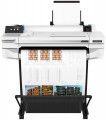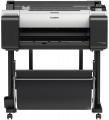Sheet printing time
Approximate time taken by the plotter to print one sheet.
This indicates for the paper size that the machine was originally designed for (see "Paper Size"). And it is approximate because it is usually given for optimal or almost optimal printing conditions: low quality and resolution, relatively simple images, etc. So the actual print time of the sheet may differ from the claimed one in one direction or another, depending on the operating parameters — starting from the mentioned quality and resolution to the type of media. However, according to the figures indicated in the specs, it is quite possible to evaluate different models and compare them with each other: the difference in the claimed time, usually, will proportionally correspond to the difference in the actual printing speed.
It is also worth noting that this time is usually indicated by the duration of the printing process itself — from the capture of the sheet by the feeder to the output of the completed print from the device. Interruptions inevitably occur between printing individual sheets, so that the total printing time is longer than the printing time of a sheet multiplied by the number of sheets. For example, a device with a time consumption of 36 sec per sheet theoretically should print about 100 sheets per hour (1 h = 3600 s, 3600/36 = 100), but in fact such a plotter usually produces about 70 – 75 sheets in this time.
Drop volume
The smallest drop volume of ink that can be produced by the printhead of an inkjet or similar plotter (see "Product Type").
This parameter is directly related to the print resolution (see “Maximum resolution”): the more dots per inch, the smaller the separate dots and, accordingly, the drops should be. At the same time, models with the same dpi number may differ slightly in this parameter. In such cases, it should be assumed that a smaller droplet volume potentially provides better print quality, with more accurate reproduction of fine lines and borders between individual areas of the image, however, such features accordingly affect the price of the device.
Media width (min)
The smallest width of paper or other media that the plotter can handle. Such devices, by definition, are designed for large-format printing and are poorly suited for small media; therefore, if you plan to frequently print on sizes smaller than standard (see "Paper Size"), you should pay attention to this parameter and make sure that the selected plotter can work with all the necessary materials.
Max. roll diameter
The largest roll diameter that can be installed in a plotter with roll printing (see above). This parameter is useful primarily for the selection of media: the material of the same width can be produced in rolls of different diameters.
Paper grammage (min)
The lowest grammage of paper that the plotter can print normally on. Grammage is expressed in grams per square metre; accordingly, the more dense the paper, the thicker it is, and the greater the difference between the minimum and maximum paper grammage, the greater the range of materials the plotter can operate with.
The use of materials that are too thin can lead to a number of troubles: multi-sheet picking, creasing, jamming, etc. Therefore, if you plan to use low-grammage paper, you should pay special attention to this characteristic.
Paper grammage (max)
The highest paper grammage that the plotter can handle normally. For details about grammage, see "Paper grammage (Min)"; and you should pay attention to its maximum value if you plan to use thick materials. Do not try to print on more dense media than it is specified in the specs of the device: even if the plotter can handle such paper normally, it can cause serious damage.
Number of cartridges
The number of individual cartridges the plotter needs to operate.
Each cartridge is responsible for its base colour used in printing. Monochrome plotters (see "Output Type"), by definition, use only one cartridge, for black colour and for such devices this parameter is usually not specified at all. But in colour printing, where all available shades are obtained by mixing basic colours, the number of such colours (and, accordingly, cartridges) can be different.
The most modest of modern colour plotters are designed to work with
4 or 5 cartridges. The first option corresponds to the CMYK colour scheme with 4 basic colours — this is the minimum required for full colour printing. In turn, 5 cartridges usually mean a CMYK colour scheme, supplemented by a separate supply of black ink for monochrome images — this allows you not to waste consumables for such images that may be needed for colour prints, and also to print monochrome even with empty colour cartridges, and vice versa.
In general, these sets of basic colours are inexpensive, while they are able to provide fairly good quality prints; so plotters for 4 – 5 cartridges are very popular nowadays. However, the use of additional basic colours can significantly increase the quality of the image, primarily the reliability of colour reproduction. Thereby, advanced plotters can provide a larger number of cartridges —
6 – 10, and s
...ometimes more. Such devices are quite expensive and difficult to maintain, but they are indispensable for printing materials with high requirements of colour quality.Cartridge model
Models of cartridges used in the plotter. With this info, you can easily find original consumables for the device.
Built-in memory
The amount of built-in memory provided in the design of the plotter.
Such memory is used to store various service data: print tasks, settings profiles, etc. Due to this, the plotter becomes more "independent": for example, many models allow you to continue printing even when the master PC is turned off.
We emphasize that in this case we are talking about solid-state flash memory, which is used mainly for "operational" service information. The capacity of such memory is relatively low, it is measured in megabytes; but in addition to it, the design may include a larger storage capacity — usually a traditional hard drive. For more information about it, see "Drive Capacity".

